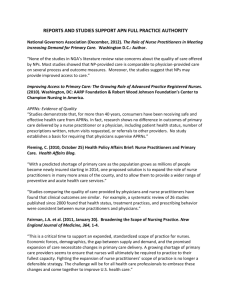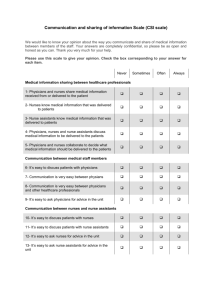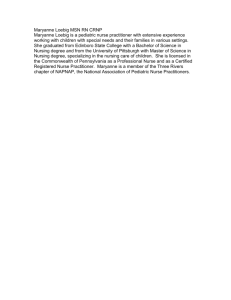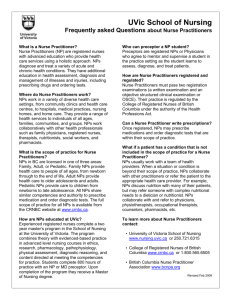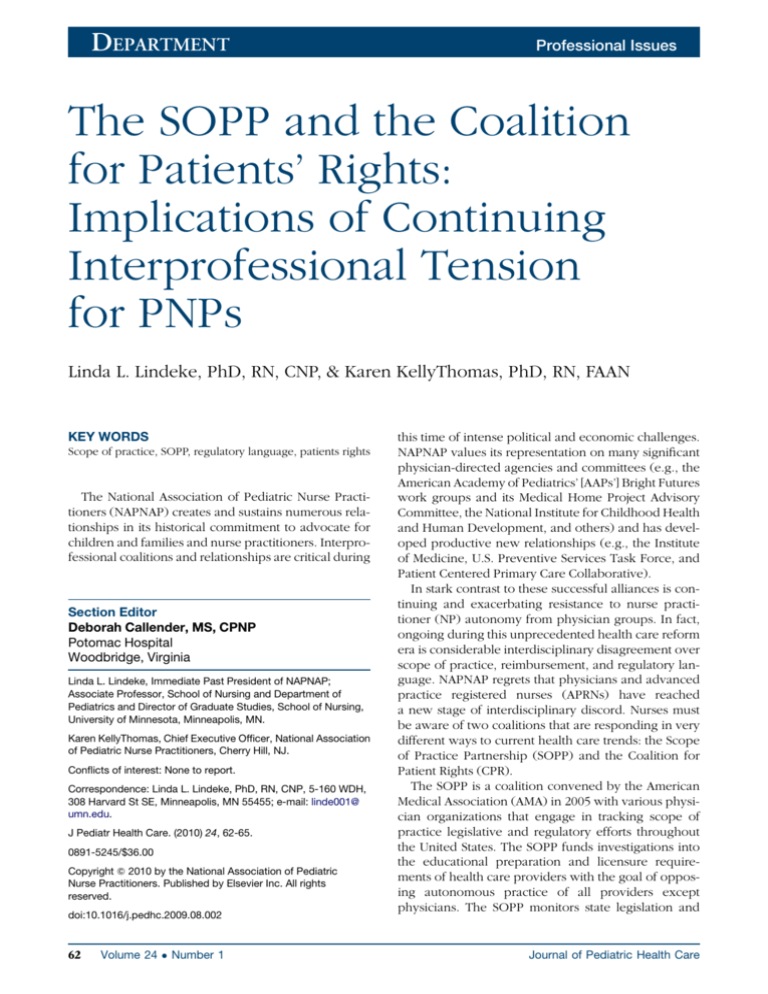
DEPARTMENT
Professional Issues
The SOPP and the Coalition
for Patients’ Rights:
Implications of Continuing
Interprofessional Tension
for PNPs
Linda L. Lindeke, PhD, RN, CNP, & Karen KellyThomas, PhD, RN, FAAN
KEY WORDS
Scope of practice, SOPP, regulatory language, patients rights
The National Association of Pediatric Nurse Practitioners (NAPNAP) creates and sustains numerous relationships in its historical commitment to advocate for
children and families and nurse practitioners. Interprofessional coalitions and relationships are critical during
Section Editor
Deborah Callender, MS, CPNP
Potomac Hospital
Woodbridge, Virginia
Linda L. Lindeke, Immediate Past President of NAPNAP;
Associate Professor, School of Nursing and Department of
Pediatrics and Director of Graduate Studies, School of Nursing,
University of Minnesota, Minneapolis, MN.
Karen KellyThomas, Chief Executive Officer, National Association
of Pediatric Nurse Practitioners, Cherry Hill, NJ.
Conflicts of interest: None to report.
Correspondence: Linda L. Lindeke, PhD, RN, CNP, 5-160 WDH,
308 Harvard St SE, Minneapolis, MN 55455; e-mail: linde001@
umn.edu.
J Pediatr Health Care. (2010) 24, 62-65.
0891-5245/$36.00
Copyright Q 2010 by the National Association of Pediatric
Nurse Practitioners. Published by Elsevier Inc. All rights
reserved.
doi:10.1016/j.pedhc.2009.08.002
62
Volume 24 Number 1
this time of intense political and economic challenges.
NAPNAP values its representation on many significant
physician-directed agencies and committees (e.g., the
American Academy of Pediatrics’ [AAPs’] Bright Futures
work groups and its Medical Home Project Advisory
Committee, the National Institute for Childhood Health
and Human Development, and others) and has developed productive new relationships (e.g., the Institute
of Medicine, U.S. Preventive Services Task Force, and
Patient Centered Primary Care Collaborative).
In stark contrast to these successful alliances is continuing and exacerbating resistance to nurse practitioner (NP) autonomy from physician groups. In fact,
ongoing during this unprecedented health care reform
era is considerable interdisciplinary disagreement over
scope of practice, reimbursement, and regulatory language. NAPNAP regrets that physicians and advanced
practice registered nurses (APRNs) have reached
a new stage of interdisciplinary discord. Nurses must
be aware of two coalitions that are responding in very
different ways to current health care trends: the Scope
of Practice Partnership (SOPP) and the Coalition for
Patient Rights (CPR).
The SOPP is a coalition convened by the American
Medical Association (AMA) in 2005 with various physician organizations that engage in tracking scope of
practice legislative and regulatory efforts throughout
the United States. The SOPP funds investigations into
the educational preparation and licensure requirements of health care providers with the goal of opposing autonomous practice of all providers except
physicians. The SOPP monitors state legislation and
Journal of Pediatric Health Care
regulation regarding scope of practice qualifications,
education, and academic requirements of ‘‘nonphysician clinicians’’ and provides this information to
its members as well as to media and policy makers.
The group is influential with federal and state legislators
and proposes to oversee and control practice of all
‘‘allied health professionals’’ in the interest of quality
patient care. Initially, state medical societies joining
SOPP were from Massachusetts, Colorado, Texas,
California, New Mexico and Maine; many other state
societies now also participate. In addition to the AMA
and its state societies, six medical specialty organizations are also part of the SOPP: The American Society
of Anesthesiologists (ASA), American Society of Plastic
Surgeons, American Academy of Otolaryngology-Head
and Neck Surgery, American Academy of Orthopedic
Surgeons, American Academy of Ophthalmology, and
American Psychiatric Association. Each organization
contributes a substantial sum annually to finance
SOPP activities.
SOPP targets all providers who are not physicians,
not just NPs. Physical therapists and chiropractors
have been targeted by SOPP, as well as psychologists
desiring prescriptive privileges and pharmacists seeking to directly work with patients in medication adjustment roles. SOPP’s use of the term ‘‘allied health
professionals’’ for all providers who are not physicians
ignores the long autonomous histories of other professions, including nursing. SOPP funds studies to examine ‘‘allied health professionals’’ in order to create
reports for legislators, and it actively campaigns against
state and federal legislation addressing the practice of
NPs and others. Numerous AMA resolutions have
been passed that reflect SOPP goals, such as the 2005
AMA Resolution 814 entitled ‘‘Limited Licensure Health
Care Provider Training and Certification Standards’’ and
the 2009 AMA Report 28 ‘‘Collaborative Practice Agreements Between Physicians and Advance Practice
Nurses.’’ The SOPP is about compensation for care,
turf, and fear of change.
The Coalition for Patients’ Rights was formed to oppose AMA and SOPP activities. Thus more than 35 organizations (listed in the Box) came together under
leadership of the American Nurses Association to resist
SOPP efforts to limit the legal authority of qualified provider groups. The name Coalition for Patients’ Rights
was chosen to emphasize that patients have the right
to choose and access quality care from the many kinds
of providers who are not physicians. NAPNAP has been
active with this Coalition since its inception in early
2006.
CPR counters claims by medicine that all health professionals should be supervised by physicians and regulated by entities comprised of physicians. Affordable,
safe care for the nation requires full use of the entire
available workforce. There are more than 3 million
health care providers in the United States who are not
www.jpedhc.org
doctors of medicine or osteopathy. The efforts of all
who are legally and educationally qualified are critical
to meet the extreme health care demand. All PNPs understand the voracious demand for care, given the increasing survival of
those born premaLeaving NPs out of
turely, the increase
demonstration
in chronic and comprojects results in
plex illnesses, the
predicted legacy of
outcomes that do not
childhood precurreflect their efforts
sors of adult disease
and keeps them
(e.g., obesity, mental health concerns,
invisible in health
and poverty), and
care/medical home
the persisting health
systems.
disparities both nationally and globally. CPR emphasizes multiple professional
approaches to quality, access, affordability, and sustainability of health care relationships.
Policy makers appear to be recognizing that NPs
are a key part of the solution for workforce shortages,
particularly when the goal is to provide care to the 45
million persons currently uninsured in the United
States. Physician efforts to restrict NP practice are receiving push-back from some lawmakers, indeed
a sign of the effectiveness of nursing’s unified lobbying in Washington and at state levels. However, statutory and regulatory language ensuring physician
control and supervision of NP practice is apparent
in some of the health care reform bills currently under
consideration. Where this is particularly noticeable is
related to the health care/medical home model of
care. The medical home model is well established in
pediatrics through state-based demonstration projects
funded by the AAP and the Maternal and Child Health
Bureau (MCHB). Medicare is now launching medical
home demonstration projects in a
It is essential that NPs
number of states.
see the SOPP for
AAP/MCHB medical
what it is: A method to
home materials have
not used providerconstrain NPs and
inclusive language
other providers who
and focus on pediaare not physicians
tricians’ skill building. Particularly in
from being fully
states where NPs
included in health
have independent
care payment reform.
practice, this exclusive focus on physician models is not in the best interests of patients or
NPs. Using provider-inclusive language and thus
ensuring NP roles in medical/health care homes is
a goal of CPR as well as multiple NP groups. Leaving
NPs out of demonstration projects results in outcomes
January/February 2010
63
that do not reflect their efforts and keeps them invisible in health care/medical home systems. NAPNAP’s
recent revision of the Position Statement on Healthcare/Medical Homes aims to clearly state the value
of PNPs’ active participation and leadership (NAPNAP,
2009).
NPs have a strong track record of working in rural
and underserved regions. Recently the SOPP published a series of maps that attempts to refute this record. The data used
All NPs must
in
creating
the
maps are from an
emphasize that there
unknown source,
is more work than
and these attempts
a single provider
to discredit nursing
are most unwelgroup can do, and
come. It is essential
every available
that NPs see the
provider needs to be
SOPP for what it is:
A method to conlegally permitted to
strain NPs and other
work to the full scope
providers who are
of his or her
not physicians from
being fully included
preparation if the
in health care payhealth of the United
ment reform. CPR
States is to be
has launched a public relations camimproved.
paign to refute the
SOPP for this divisive movement and to educate consumers about their health care provider choices. Cost
containment is a key goal of President Obama’s administration, payers, and the public. CPR is growing in its
influence.
Unfortunately, physician organizations sometimes
discredit the quality of care of other providers in order
to remain the main recipients of payment. Clearly, no
other provider group is as costly as physician care providers. PNPs know that primary care physicians are
much less costly than specialty and subspecialty physicians, so considerable battles exist between those two
types of physician providers for reimbursement within
evolving payment systems. Physician groups aim to select the kinds of patients that NPs can see and typically
state that NPs should not see persons with complex
problems or multiple diagnoses, undiagnosed patients,
or those with difficult management challenges. This position has been taken in spite of the fact that there is no
evidence to indicate that in 45 years NPs have been unsafe or ineffective with any population group. In fact,
many NPs are hired to work with complex patients in
chronic care or acute care settings. They typically receive far less compensation than physicians for doing
so, although recently the gap between NP and primary
care physician salaries has narrowed. All NPs must emphasize that there is more work than a single provider
group can do, and every available provider needs to
64
Volume 24 Number 1
be legally permitted to work to the full scope of his or
her preparation if the health of the United States is to
be improved.
In summary, since 2006, progress has been made in
that many more nursing and other health care professional providers are more united and speaking out
against the SOPP’s reprehensible work. The Coalition
for Patients Rights advocates three statements:
1. A national coalition of more than 35 organizations,
the Coalition for Patients’ Rights, represents more
than 3 million licensed health care professionals
committed to ensuring comprehensive health care
choices for all patients.
BOX. 2009 members of the Coalition for
Patient Rights
d
d
d
d
d
d
d
d
d
d
d
d
d
d
d
d
d
d
d
d
d
d
d
d
d
d
d
d
d
d
d
d
d
d
d
d
d
American Academy of Nurse Practitioners
American Association for Marriage and Family Therapy
American Association of Colleges of Nursing
American Association of Critical-Care Nurses
American Association of Naturopathic Physicians
American Association of Nurse Anesthetists
American Association of Acupuncture and Oriental
Medicine
American Association of Occupational Health Nurses
American Chiropractic Association
American College of Nurse-Midwives
American College of Nurse Practitioners
American Nephrology Nurses Association
American Nurses Association
American Occupational Therapy Association
American Physical Therapy Association
American Psychological Association
American Psychiatric Nurses Association
American Speech-Language Hearing Association
Association of Nurses in AIDS Care
Association of Perioperative Registered Nurses
Association of Rehabilitation Nurses
Association of Schools of Allied Health Professions
Association of Women’s Health, Obstetric and Neonatal
Nurses
California Optometric Association
Emergency Nurses Association
Hospice and Palliative Nurses Association
Integrated Health Policy Consortium
National Association of Clinical Nurse Specialists
National Association of Nurse Practitioners in Women’s
Health
National Association of Pediatric Nurse Practitioners
National Council of State Board of Nursing
National League for Nursing
National Nursing Centers Consortium
National Organization of Nurse Practitioners Faculties
Oncology Nursing Society
Preventive Cardiovascular Nurses Association
Wound Ostomy and Continence Nurses Society
Journal of Pediatric Health Care
2. The Coalition for Patients’ Rights advocates for
patients, protecting their right to access care
from a broad spectrum of health care professionals.
3. There is a divisive movement to restrict the valuable
services provided by some health care professionals,
which will limit patient access to safe, high-quality,
and cost-effective health care.
www.jpedhc.org
Help spread these messages to improve the system
for optimum health and well-being of our children,
their families, and those dedicated to their care!
REFERENCE
National Association of Pediatric Nurse Practitioners. (2009). Pediatric healthcare/medical home: Key issues on delivery, reimbursement and leadership position statement. Journal of
Pediatric Health Care, 23, 23A-24A.
January/February 2010
65



